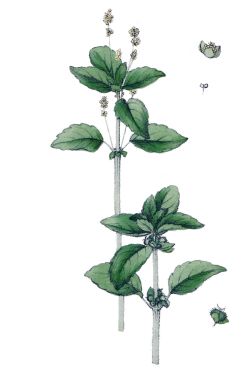Subfamily Acalyphoideae
Tribe Acalypheae
There are 12 subtribes and 32 genera:
- Subtribe Acalyphinae
- Acalypha (also Acalyphes, Acalyphopsis, Calyptrospatha, Caturus, Corythea, Cupameni, Galurus, Gymnalypha, Linostachys, Mercuriastrum, Odonteilema, Paracelsea, Ricinocarpus, Schizogyne, Usteria)
- Subtribe Adrianinae
- Adriana (also Meialisa, Trachycaryon)
- Subtribe Claoxylinae
- Claoxylon (also Erythrochilus, Erythrochylus)
- Claoxylopsis
- Discoclaoxylon
- Erythrococca (also Athroandra, Autrandra, Chloropatane, Deflersia, Poggeophyton, Rivinoides)
- Micrococca
- Subtribe Cleidiinae
- Cleidion (also Lasiostyles, Psilostachys, Redia, Tetraglossa)
- Sampantaea
- Wetria (also Pseudotrewia)
- Subtribe Dysopsidinae
- Dysopsis (also Mirabellia, Molina)
- Subtribe Lasiococcinae
- Clonostylis
- Homonoia (also called Haematospermum, Lumanaja])
- Lasiococca
- Spathiostemon (also Polydragma)
- Subtribe Lobaniliinae
- Lobanilia
- Subtribe Macaranginae
- Macaranga (also Adenoceras, Mappa, Mecostylis, Pachystemon, Panopia, Phocea, Tanarius)
- Subtribe Mareyinae
- Mareya
- Mareyopsis
- Subtribe Mercurialinae
- Mercurialis (also Cynocrambe, Discoplis, Synema)
- Leidesia
- Seidelia
- Subtribe Ricininae
- Ricinus - castor bean
- Subtribe Rottlerinae
- Avellanita
- Deuteromallotus
- Hancea
- Mallotus (also Aconceveibum, Axenfeldia, Coelodiscus, Diplochlamys, Echinocroton, Echinus, Hancea, Lasipana, Plagianthera, Rottlera,Stylanthus)
- Rockinghamia
Tribe Adelieae
There are 6 genera:
- Adelia (also Ricinella)
- Crotonogynopsis
- Enriquebeltrania (also Beltrania)
- Garciadelia
- Lasiocroton
- Leucocroton
Tribe Agrostistachydeae
There are 4 genera:
- Agrostistachys (also Heterocalyx, Sarcoclinium)
- Chondrostylis (also Kunstlerodendron)
- Cyttaranthus
- Pseudagrostistachys
Tribe Alchorneae
There are 2 subtribes and 7 genera:
- Subtribe Alchorneinae
- Alchornea (also Bleekeria, Cladodes, Hermesia, Lepidoturus, Schousboea, Stipellaria)
- Aparisthmium
- Aubletiana
- Bocquillonia (also Ramelia)
- Orfilea (also Diderotia, Laurembergia)
- Subtribe Conceveibinae
- Conceveiba (also Conceveibastrum, Conceveibum, Veconcibea)
- Gavarretia
- Polyandra
Tribe Ampereae
There are 2 genera:
- Amperea (also Leptomeria)
- Monotaxis (also Hippocrepandra, Reissipa)
Tribe Bernardieae
There are 6 genera:
- Adenophaedra
- Amyrea
- Bernardia (also Alevia, Bernarda, Bernhardia, Bivonia, Passaea, Phaedra, Polyboea, Traganthus, Tyria)
- Discocleidion
- Necepsia (also Neopalissya, Palissya)
- Paranecepsia
Tribe Caryodendreae
There are 3 genera:
- Alchorneopsis
- Caryodendron (also Centrodiscus)
- Discoglypremna
Tribe Chaetocarpeae
This tribe has 2 genera:
- Chaetocarpus (also Gaedawakka, Mettenia, Neochevaliera, Regnaldia)
- Trigonopleura (also Peniculifera)
Tribe Cheiloseae
There are 2 genera:
- Cheilosa
- Neoscortechinia (also Alcineanthus, Scortechinia)
Tribe Chrozophoreae
This tribe has 4 subtribes and 12 genera:
- Subtribe Chrozophorinae
- Chrozophora (also Crossophora, Crozophora, Ricinoides, Tournesol, Tournesolia)
- Subtribe Ditaxinae
- Argythamnia (also Argithamnia, Argothamnia, Argyrothamnia, Argytamnia, Odotalon, Serophyton)
- Caperonia (also Acanthopyxis, Androphoranthus, Cavanilla, Lepidococea, Meterana)
- Chiropetalum (also Aonikena, Desfontaena, Desfontaina, Desfontainea)
- Ditaxis (also Aphora, Paxiuscula, Stenonia)
- Philyra (also Phyllera)
- Subtribe Doryxylinae
- Doryxylon (also Mercadoa, Sumbavia)
- Melanolepis
- Sumbaviopsis (also Adisa, Adisca)
- Thyrsanthera
- Subtribe Speranskiinae
- Speranskia

Tribe Dicoelieae
This tribe has one genus:
- Dicoelia
Tribe Epiprineae
There are 2 subtribes and 9 genera:
- Subtribe Epiprininae
- Adenochlaena (also Niedenzua, Centrostylis)
- Cephalocroton
- Cephalocrotonopsis
- Cladogynos (also Adenogynum, Baprea, Chloradenia)
- Cleidiocarpon (also Sinopimelodendron)
- Epiprinus
- Koilodepas (also Caelodepas, Calpigyne, Coelodepas, Nephrostylus)
- Subtribe Cephalomappinae
- Cephalomappa
- Muricococcum
Tribe Erismantheae
There are 3 genera:
- Erismanthus
- Moultonianthus
- Syndyophyllum
Tribe Omphaleae
This tribe only has 1 genus:
- Omphalea (also Duchola, Hebecocca, Hecatea, Neomphalea, Omphalandria, Ronnowia)
Tribe Plukenetieae
There are 3 subtribes and 13 genera:
- Subtribe Dalechampiinae
- Dalechampia (also Cremophyllum, Dalechampsia, Megalostylis, Rhopalostylis)
- Subtribe Plukenetiinae
- Angostylis (also Angostyles)
- Astrococcus
- Haematostemon
- Plukenetia (also Accia, Angostylidium, Apopandra, Botryanthe, Ceratococcus, Elaeophora, Eleutherostigma, Fragariopsis, Hedraiostylus, Pseudotragia, Pterococcus, Sajorium, Tetracarpidium or Vigia)
- Romanoa (also Anabaena, Anabaenella)
- Subtribe Tragiinae
- Acidoton (also Durandeeldia, Gitara)
- Bia
- Cnesmone (also Cenesmon, Cnesmosa)
- Megistostigma (also Clavistylus)
- Pachystylidium
- Platygyna (also Acanthocaulon)
- Sphaerostylis
- Tragia (also Agirta, Allosandra, Ctenomeria, Lassia, Leptobotrys, Leptorhachis, Leucandra, Schorigeram, Zuckertia )
- Tragiella
Tribe Pycnocomeae
There are 2 subtribes and 7 genera:
- Subtribe Blumeodendrinae
- Blumeodendron
- Botryophora (also Botryospora, Botryphora)
- Podadenia
- Ptychopyxis (also Clarorivinia)
- Subtribe Pycnocominae
- Argomuellera (also Neopycnocoma, Wetriaria)
- Droceloncia
- Pycnocoma (also Comopyena)
Tribe Sphyranthereae
There is only 1 genus:
- Sphyranthera